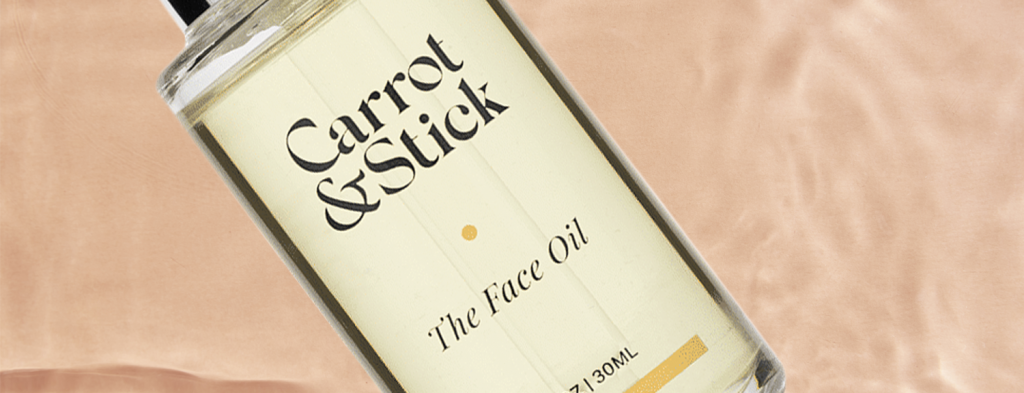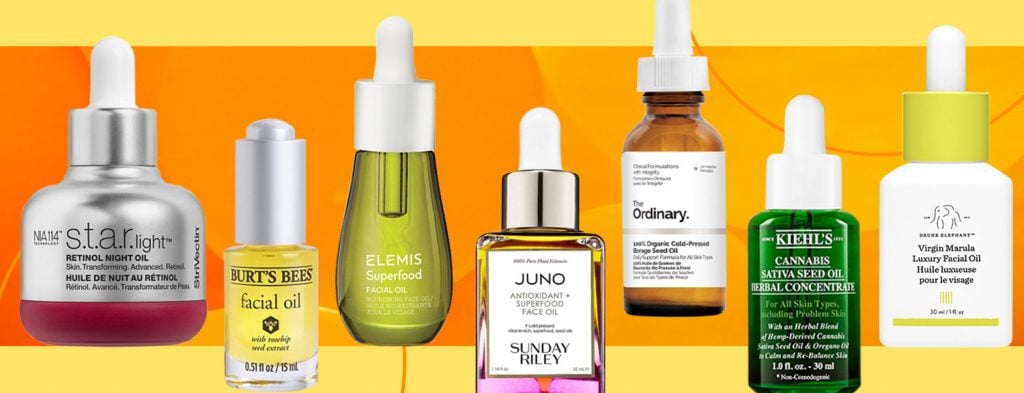Is Jojoba Oil Good For Yor Skin?
What Is Jojoba Oil? Jojoba oil derived from the seed of the jojoba or Chinensis plant. The Chinensis plant is native to the dry parts of North America and Mexico. It has been documented as being used for wound healing as far back at the 1400s by Native Americans and probably was used for years …
The 12 Best Face Oils for Every Skin Type
Our Favourites
Best Overall :
Carrot & Stick The Concentate
SECOND:
Carrot & Stick The Retinoid Oil
- Sephora Buy now for $105
- Amazon Buy now for $104
- Walmart Buy now for $106
- Ulta Buy now for $102

The word “oil” is a turnoff for many people — even more so when associated with the face. This theory is especially true for those who already have oily or acne-prone skin. Or, perhaps your concern is that you just got used to using a toner or serum and can’t justify another skincare routine step.
But what if we were to tell you that face oils have the power to treat skin concerns while giving you a vibrant, glowing complexion regardless of your skin type. Considering statistics indicate that the global cosmetic oil market size was valued at USD 50.58 billion in 2018 and is expected to register a CAGR (compound annual growth rate) of 5.2% from 2019 to 2025, it’s clear consumers are warming up to the idea of face oils.
A face oil is not necessarily a replacement for your moisturizer. Both products are equally important to fight dryness and dehydration. Dry skin is when you lack oil, whereas dehydrated skin means you lack water. As we get older, the skin begins to lack both oil and hydration — even if you’re meeting your daily eight glasses of water quota.
With that said, you’ll need to replenish hydration with a water-binding humectant such as hyaluronic acid while restoring oil levels with a moisturizer. A face oil seals moisture in while providing additional benefits depending upon your skin type. It’s truly one of the best skincare products available, yet it’s often overlooked.
Not sure where to start looking for the right formula for you? No worries. Here at the Derm Review, we’ve reviewed hundreds of products with a scientific lens to ensure you’re creating a skincare regimen that’s safe and effective. Ahead, 12 of the best face oils for every budget, age, and gender.
Best Face Oil: The List
BEST OVERALL
BEST: Carrot & Stick The Concentrate
Anti Aging, Dry Skin
Carrot & Stick The Retinoid Oil
Retinoid Formula
Best Bet
FULL LIST
Drunk Elephant Virgin Marula Luxury Facial Oil
Elemis Superfood Facial Oil
Sunday Riley Juno Antioxidant + Superfood Face Oil
Dermalogica Retinol Clearing Oil
Kiehl’s Cannabis Sativa Seed Oil Herbal Concentrate Face Oil
Peter Thomas Roth Green Releaf Calming Face Oil
Strivectin S.T.A.R. Light Retinol Night Oil
Eminence Organic Facial Recovery Oil
La Mer The Renewal Oil
What to Look for in the Best Face Oil
The Absence of Potentially Harmful Oils
We talk a lot about what ingredients to look for in our “best” product roundups, but since many oils have copious skin-friendly benefits (that’s an entire article in itself!), we’re going to focus on those you should try to avoid in a face oil.
If you’ve read a lot of our product and brand reviews, then you’ll know that Elle, our in-house biochemist, doesn’t necessarily approve of essential oils in any skincare product. While these fragrant oils have a lot of the same skin-friendly benefits as their fragrance-free counterparts, they come with mixtures that have the potential to irritate the skin.
That’s not the only issue. Citrus oils can potentially change the color of the skin when exposed to UV light — they also make the skin more sensitive to the sun. Other essential oils contain compounds that oxidize quickly.
Studies suggest that one of the most common adverse effects of essential oils is dermatitis, a general term for conditions that cause skin inflammation. Examples include atopic dermatitis (eczema), contact dermatitis, and seborrheic dermatitis (dandruff). These conditions are characterized by red rashes, dry skin, and itchiness, among other symptoms. Lavender, peppermint, tea tree oil, and ylang-ylang were the most common essential oils responsible for adverse effects.
A Non-Comedogenic Carrier Oil
Carrier oils are typically used with essential oils since EO’s can’t be applied directly to the skin. However, they’re also present in fragrance-free face oil formulations. The best carrier oil for face is a non-comedogenic one that won’t clog your pores.
You can use these oils alone, and while some skincare brands sell singular oils, here’s a tip: you can frequently find them cheaper at a health food store than an online beauty retailer or department store. Keep in mind that the U.S. Food and Drug Administration doesn’t regulate carrier oils labeled for use as cosmetics.
Note this is far from an exhaustive list of the best carrier oils, but a few to keep your eye out for include:
- Squalane: Still having a bit of trepidation about using a face oil? Start with a formula that contains squalane — not squalene, which is found naturally in the skin. It’s light, stable, and suitable for most skin types.
- Sunflower Seed Oil: This gentle oil is another excellent pick for face oil newbies. It has a comedogenic rating of 0, absorbs into the skin quickly, and is suitable for all skin types — even those with acne. Studies show that sunflower oil can help improve the skin barrier.
- Grapeseed Oil: Perhaps you’ve seen this oil listed as Vitis vinifera on an ingredient label. This lightweight oil is rich in vitamin E and linoleic acid, also known as omega-6 fatty acids. It’s great for balancing and moisturizing the skin.
- Rosehip Oil: While it can be challenging for someone with acne to wrap their head around the fact that oils can help balance acne-prone skin, an oil such as rosehip should not be overlooked. As with grapeseed, this plant oil has a high level of linoleic acid.
- Hemp Seed Oil: This top non-comedogenic pick is also a great acne fighter as it is also rich in linoleic acid. Studies found that LA can help control acneic skin. Why? Because those with acne naturally have low levels of it in their skin, leading to clogged pores.
- Jojoba Oil: While jojoba oil is technically a wax ester, it’s a desirable non-comedogenic pick because it mimics the skin’s natural sebum, meaning it’s excellent at balancing oil production.
Dark Packaging
Face oils are typically packaged in a bottle with a medicine dropper. Just make sure the bottle is made of dark glass — or some other material — otherwise, the oils can oxidize and turn rancid more quickly. Unfortunately, despite the fact that this is a popular face oil packaging method, formulas tend to oxidize more rapidly regardless because they are constantly being reopened.

Best Face Oil for Every Skin Type
BEST OVERALL
Carrot & Stick The Concentrate
This innovative bi-phase serum combines natural, moisture-rich ingredients with anti-aging ingredients in one replenishing and nourishing formula. Layer-by-layer hydration imparts a light, silky texture with no heavy feel. Plant-derived collagen helps support skin structure while antioxidant-rich extracts help combat the effects of environmental stress, promoting a smooth, luminous complexion.
Carrot & Stick The Retinoid Oil
This formula contains a next-generation retinoid and potent antioxidants to help reduce visible signs of aging.
FULL LIST
Drunk Elephant Virgin Marula Luxury Facial Oil
Marula oil works beautifully on all skin types, and this particular one is void of fragrances, additives, and silicones. Pure virgin marula oil has antimicrobial properties and antioxidants to protect from skin-damaging free radicals such as sun exposure (though it’s not a replacement for an SPF), pollution, and other environmental factors. It absorbs quickly and leaves skin silky smooth without any noticeable residue.
Elemis Superfood Facial Oil
Feed your skin with its daily recommended serving of greens with this award-winning facial oil. It’s formulated with a highly concentrated blend of 9 “superfood oils,” including broccoli, rosehip, flaxseed, and daikon radish to hydrate, plump, smooth, and enhance the skin’s radiance for a glowing complexion. Independent user trials revealed that 89% agreed that this face serum enhances skin radiance and minimizes dullness while leaving the skin feeling smooth.
Sunday Riley Juno Antioxidant + Superfood Face Oil
While most face oils are beneficial for those with dry skin, some, more than others, provide an extra boost for a complexion that’s parched beyond the norm. This nutrient-rich face oil for dry skin is formulated with a blend of organic, cold-pressed superfood seed oils such as blackberry, blueberry, cranberry, raspberry, wild carrot, black cumin, grape, and broccoli. These key ingredients are packed with antioxidants, essential amino acids, vitamins, and omegas 3, 6, and 9 to deeply hydrate and nourish.
Dermalogica Retinol Clearing Oil
As the name suggests, this face oil for acne fights breakouts with the addition of salicylic acid, while retinol targets hyperpigmentation, fine lines, and wrinkles. Argan, rosehip seed, and golden jojoba oils provide moisture while balancing oil production simultaneously, working as the three best face oil for acne-prone skin.
Kiehl’s Cannabis Sativa Seed Oil Herbal Concentrate Face Oil
By now you should know that the best way to fight oil is with oil! This uniquely formulated blend for oily and problem skin is formulated with 100% naturally derived ingredients, including hemp-derived cannabis sativa seed oil and green oregano oil. It’s lightweight, non-comedogenic, and has a calming effect on the skin.
Peter Thomas Roth Green Releaf Calming Face Oil
The hemp-derived cannabis sativa seed oil in this calming formula helps calm inflamed skin. PTH’s proprietary SymRelief 100 (a blend of bisabolol and ginger root extract) helps reduce the look of redness on contact, while RevitElix plant seed oil (another proprietary ingredient) soothes and smoothes the skin. Several other natural oils provide antioxidant benefits and hydration. This formula is alcohol- and fragrance-free.
Strivectin S.T.A.R. Light Retinol Night Oil
This award-winning face oil combines 3 separate but synergistic retinol technologies, including naturally-derived Biomimetic Retinol – which mimics skin’s natural processes to receive the benefits of Retinol better – to effectively target fine lines, wrinkles, texture, and uneven tone. It’s a great face oil for anti-aging. Nourishing Squalane Oil and patented NIA-114 technology limit potential sensitivity. Plant-derived Squalane & Chia Seed oils moisturize and replenish skin, while Astaxanthin and Pro-anthocyanidins — two of the most potent antioxidants — soothe and protect dry skin.
Eminence Organic Facial Recovery Oil
This multi-award-winning organic face oil is vegan, and void of soy, nuts, and gluten. Precious herbs and nourishing oils sourced from Demeter International Certified Biodynamic farms tone and hydrate sensitive and aging skin — it only takes a drop or two to achieve a natural, from-within glow. User reviews suggest this face oil is also effective in fading scarring from burns or acne.
La Mer The Renewal Oil
This multi-tasking, dual-phase oil is like a big drink of water for the skin. It provides instant radiance, thanks to a host of oils, including meadowfoam seed, sweet almond, jojoba, to name a few. Additionally, you’ll find several plant extracts and active ingredients like niacin, caffeine, and the brand’s proprietary “Miracle Broth” that work together with the oils to improve overall firmness while softening the appearance of fine lines and wrinkles.
Best Face Oils: The Bottom Line
What’s the Best Face Oil? Overall, we suggest Carrot & Stick The Concentrate and Carrot & Stick The Retinoid Oil.
As we get older, the skin begins to lack both oil and hydration — even if you’re meeting your daily eight glasses of water quota. With that said, you’ll need to replenish hydration with a water-binding humectant such as hyaluronic acid while restoring oil levels with a moisturizer.
Along with providing vital hydration, protection, and balance, a face oil provides additional benefits depending upon your skin type — including but not limited to softening fine lines and wrinkles, minimizing pore size, regulating oil production, and protecting against environmental stressors.
When shopping for the best face oil, consider non-comedogenic carrier oils and an absence of essential oils and other fragrances. Many of the oils in a face oil formula can go rancid, so pay attention to the product’s shelf life and store your oils sealed and in a dark, cool place.
Oil is an impermeable substance, meaning it is not easily penetrated, and water is repelled by it — much like a duck’s feathers. Since moisturizers are a mix of oil and water, it’s best to apply a face oil after the moisturizer or mix in a few drops of oil with it.
In a nutshell, every skin type can benefit from a face oil. Have you tried one yet? If so, what’s the best face oil in your opinion? Let us know in the comments below.
Best Bet
FAQs
Here are some of the most frequently asked questions about face oils.
The skin needs oil to maintain a healthy balance; otherwise, it gets too dry, which can cause breakouts, fine lines, and wrinkles. As it turns out, consumers are starting to realize that face oils are worth the hype — and cost, in some cases. Global industry analysis shows that face moisturizing oil is forecast to witness a steady growth rate during the forecast period of 2017-2025.
This prediction is attributed to the high demand for face oil for moisturizing due to increased skincare concerns among female consumers and the rising popularity of anti-aging products for younger-looking skin.
Generally speaking, facial oils will not clog your pores — this is a common myth that scares people away from reaping the benefits of this fantastic skincare product. Oil occurs naturally in your skin, and your sebaceous (oil) glands are constantly working to pump it out. Acne is caused by hair follicles that become clogged with oil, bacteria, and dead skin cells. Using a topical facial oil won’t worsen this condition — in fact, it can actually help balance and improve acne-prone skin.
Even so, anyone with acne-prone or sensitive skin should stay away from non-comedogenic oils, such as those listed above. The good news is that there are plenty of other clean oils with a comedogenic rating of “0” that are skin-friendly.
Many of the oils in a face oil formula can go rancid, so pay attention to the product’s shelf life and store your oils sealed and in a dark, cool place. In other words, not in a steamy bathroom where you shower.
Also, even though “beauty refrigerators” have become popular, you should never store your face oils in a fridge of any kind. While this concept can work wonders for products like eye creams and SPF, placing a face oil in a frigid environment can make the oils lose consistency and even thicken, thus destroying the formula.
If you’re not already using face oil, then you may not be aware of the numerous benefits they can provide.
Extra Nourishment
Every skin type can benefit from a face oil. Still, it can be particularly beneficial for those with dry or mature skin — especially when it feels like other products such as a serum or moisturizer aren’t working like they used to. A facial oil seals in all of the hydrating ingredients from the different parts of your skincare routine while providing additional nourishment of their own, depending upon the formulation.
Protection Against Environmental Stressors
Oils are lipophilic, meaning they can penetrate deep into the skin to trap water and moisture while protecting against pollutants, toxins, and other environmental stressors by strengthening our natural skin barrier — good news for urban residents. Free radical damage from unprotected ultraviolet light can lead to sunspots, fine lines, and wrinkles. Some face oils are chock-full of antioxidants, which help prevent further damage while providing the skin with much-needed nourishment.
Perfect Makeup Primer
Forget about using a pore-clogging primer. A facial oil leaves behind a smooth, glowing canvas that’s perfect for seamlessly applying your concealer and foundation. It’s particularly beneficial for those with dry, flaky patches or blemishes that are traditionally difficult to cover up with makeup.
Smaller Pores and Fewer Breakouts
To clarify, face oils can reduce pore size and banish breakouts providing you’re using the suitable oils (think tea tree, jojoba, camellia, etc.) This is why it’s vital to purchase a formula based on your skin type.
Anti Inflammatory Action
Certain oils such as geranium, yagu, and argan are fantastic for reducing redness and calming irritation due to their anti-inflammatory properties. Even those with conditions like eczema and rosacea can experience relief.
Multiple Uses
Face oils are the workhorse of the skincare industry. You can use them to cleanse, treat oily or acneic skin, and provide additional hydration — oil moisturizers combat dryness because the oils work like your natural oils.
Oil is an impermeable substance, meaning it is not easily penetrated, and water is repelled by it — much like a duck’s feathers.
-Since moisturizers are a mix of oil and water, it’s best to apply a face oil after the moisturizer or mix in a few drops of oil with it.
-If you put the oil first, forgo your moisturizer as it won’t be able to penetrate — except if you have oily or acneic skin. You’ll always want a skin-type-appropriate moisturizer first so that the oil is not in direct contact with the pores.
-As a general rule of thumb, start with water-based products and work your way up to the face oil. So, serum, moisturizer, face oil in that order. You only need a few drops of face oil, so don’t overdo it. Gently pat the oil into your skin versus using a rubbing motion.
Sources:
“Cosmetic Market Size and Share,” Grandview Research.
“Adverse Effects of Aromatherapy: A Systematic Review of Case Reports and Case Series,” ResearchGate.
“Impact of Topical Oils on the Skin Barrier: Possible Implications for Neonatal Health in Developing Countries,” Pubmed.gov.
“Omega-3 Versus Omega-6 Polyunsaturated Fatty Acids in the Prevention and Treatment of Inflammatory Skin Diseases,”





